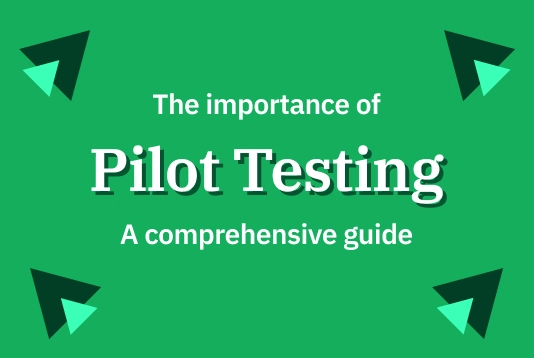Table content
Imagine a beauty company preparing to launch a new product—a luxurious new cream. Armed with data and insights, they are confident that the product will deliver remarkable results. However, even the most data-driven organizations can find themselves at a crossroads when it comes to meeting consumer needs.
Recognizing the importance of understanding their target audience, this beauty company is eager to gather real-world feedback before making a full-scale launch. This leads them to consider pilot testing—a process that gathers real-world feedback before the full-scale launch, so changes can be made, ensuring success for all.
What is Pilot Testing
Pilot testing, often referred to as a “pre-test” or “trial run,” is a small-scale version of a study or product test conducted to identify potential issues or areas for improvement. It allows researchers or product developers to refine their methodologies, procedures, and tools, ensuring that the full-scale implementation runs smoothly.
In the context of survey research, pilot testing typically involves sending a survey to a small sample of the full audience to test questions and formats before conducting the actual survey on a larger scale. Tools like LimeSurvey are particularly useful in pilot testing surveys, offering features that make it easy to design, execute, and analyze the outcomes of pilot tests effectively.
The Role of Pilot Testing in Research
Pilot testing plays an essential role in research by helping identify potential errors or flaws in the research design. This phase helps researchers ensure that their instruments, like surveys or questionnaires, function as intended. It also allows researchers to fine-tune their data collection methods, ensuring clarity and precision in questions, especially when using online survey tools like LimeSurvey.
In scientific research, pilot testing enables researchers to test hypotheses, refine experimental procedures, and ensure the validity of the data collection instruments. It also highlights any unforeseen challenges that may arise, such as participant misunderstandings or technical issues, which can then be resolved before the full study is carried out.
Importance of Pilot Testing in Research and Product Development
Pilot testing is vital in both research and product development for the following reasons:
- Cost-effectiveness: Conducting a pilot test saves time and resources. Identifying and fixing issues in the early stages is more cost-effective than dealing with them during the full-scale implementation.
- Error Reduction: Pilot tests minimize the chances of errors in the fully launched version by detecting potential flaws, whether they are in the survey questions, product design, or user interface.
- Improved Data Quality: By testing the survey before it is sent out widely, researchers can ensure they collect high-quality, reliable data. For instance, LimeSurvey allows users to easily tweak surveys based on pilot test feedback, ensuring that the final survey runs smoothly.
- Stakeholder Confidence: Demonstrating the success of a pilot test builds stakeholder confidence, ensuring that the research or product will likely succeed in the larger phase.
Key Steps When Designing a Pilot Test
To effectively design and implement a pilot test, follow these key steps:
- Define Objectives: Clearly state what you want to achieve with the pilot test. Identify specific questions or challenges you aim to address.
- Develop a Test Plan: Outline the scope of the pilot test, including the number of participants, the tools to be used (like LimeSurvey for survey testing), and the timeframe.
- Select a Sample Group: Choose a sample group that closely represents your target population. The sample size should be large enough to detect any issues, but small enough to be manageable.
- Conduct the Pilot Test: Execute the test according to the plan. Whether it’s running a small-scale survey or testing a product feature, pay close attention to the results and feedback.
- Analyze the Data: Evaluate the data collected during the pilot test. Look for patterns that indicate potential problems, and consider whether any changes need to be made before moving to the full-scale phase.
Creating a Pilot Test Questionnaire
If your pilot test involves a survey, it is critical to create an effective questionnaire. Here’s how you can ensure your pilot test questionnaire is successful.
- Clarity of Questions: Ensure that questions are clear and easy to understand. Pilot testing can help identify any ambiguous or confusing wording.
- Length of the Survey: Keep your pilot survey short but comprehensive enough to test all key aspects. Use LimeSurvey to structure the survey and check how respondents interact with the questions.
- Relevance of Questions: Ensure the questions are relevant to the research objectives. Pilot testing allows you to discard irrelevant or redundant questions.
- Feedback Mechanism: Include an open-ended feedback section to gather respondents’ insights on the survey experience itself. This feedback can be used to improve the final version.
Common Issues in Pilot Testing
Despite its advantages, pilot testing comes with its own set of challenges:
- Limited Sample Size: The small scale of pilot tests may not always reveal all potential problems, especially those that only arise in large populations.
- Time Constraints: Rushing a pilot test to meet deadlines may lead to incomplete or inaccurate findings.
- Participant Engagement: In some cases, participants in the pilot may not take the test seriously, which can skew results.
- Over-reliance on Pilot Results: While pilot testing is useful, it’s not foolproof. Full-scale testing is still necessary to validate the findings of the pilot phase.
Best Practices for Conducting a Pilot Test
To get the most out of your pilot testing phase, start by engaging stakeholders early in the planning and analysis stages to ensure that the test aligns with broader project goals.
Then, document everything and record all aspects of the pilot test, including objectives, procedures, results, and challenges. This documentation will serve as a guide for the full-scale implementation.
Be prepared to make adjustments based on the pilot test findings. Whether it’s refining survey questions on LimeSurvey or tweaking a product design, use the feedback to improve the final version. Ensure the pilot test mimics real-world conditions as closely as possible. This will give you a better sense of how the full-scale version will perform.
Evaluating and Interpreting Pilot Test Results
Once the pilot test is complete, the next step is to evaluate and interpret the results. Here’s how:
- Quantitative Data Analysis: If you’re conducting a survey, tools like LimeSurvey can help you analyze the data, offering insights into response rates, question completion times, and participant feedback.
- Qualitative Feedback: Pay close attention to open-ended feedback provided by participants. This can provide rich insights into areas that need improvement.
- Identify Key Learnings: Summarize the key takeaways from the pilot test and use these insights to adjust your plan for the full-scale test.
Conduct Pilot Testing With LimeSurvey
Pilot testing is an indispensable part of research and product development. It helps refine methodologies, identify potential issues, and improve overall outcomes.
By using tools like LimeSurvey, researchers and developers can streamline the pilot testing process, ensuring that both small-scale and full-scale implementations are successful.




